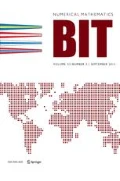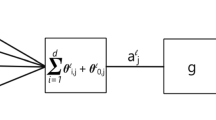Abstract
Most algorithms for choosing the regularization parameter in a discrete ill-posed problem are based on the norm of the residual vector. In this work we propose a different approach, where we seek to use all the information available in the residual vector. We present important relations between the residual components and the amount of information that is available in the noisy data, and we show how to use statistical tools and fast Fourier transforms to extract this information efficiently. This approach leads to a computationally inexpensive parameter-choice rule based on the normalized cumulative periodogram, which is particularly suited for large-scale problems.
Similar content being viewed by others
References
A. Boggess and F. Narcowich, A First Course in Wavelets with Fourier Analysis, Prentice Hall, New Jersey, 2001.
V. Faber, A. Manteuffel, A. B. White Jr., and G. M. Wing, Asymptotic behavior of singular values and functions of certain convolution operators, Comput. Math. Appl., 12A (1986), pp. 733–747.
W. A. Fuller, Introduction to Statistical Time Series, 2nd edn., Wiley, New York, 1996.
R. R. Goldberg, Methods of Real Analysis, 2nd edn., Wiley, New York, 1976.
P. C. Hansen, Computation of the singular value expansion, Computing, 40 (1988), pp. 185–199.
P. C. Hansen, Analysis of discrete ill-posed problems by means of the L-curve, SIAM Rev., 34 (1992), pp. 561–580.
P. C. Hansen, Regularization Tools: A Matlab package for analysis and solution of discrete ill-posed problems, Numer. Algorithms, 6 (1994), pp. 1–35.
P. C. Hansen, Rank-Deficient and Discrete Ill-Posed Problems, SIAM, Philadelphia, 1998.
P. C. Hansen, Deconvolution and regularization with Toeplitz matrices, Numer. Algorithms, 29 (2002), pp. 323–378.
M. E. Kilmer and D. P. O’Leary, Choosing regularization parameters in iterative methods for ill-posed problems, SIAM J. Matrix Anal. Appl., 22 (2001), pp. 1204–1221.
R. Kress, Linear Integral Equations, 2nd edn., Springer, Heidelberg, 1999.
J. G. Nagy, K. Palmer and L. Perrone, Iterative methods for image deblurring: A Matlab object-oriented approach, Numer. Algorithms, 36 (2004), pp. 73–93.
D. P. O’Leary, Near-optimal parameters for Tikhonov and other regularization methods, SIAM J. Sci. Comput., 23 (2001), pp. 1161–1171.
B. W. Rust, Truncating the Singular Value Decomposition for Ill-Posed Problems, Report NISTIR 6131, Mathematical and Computational Sciences Division, NIST, 1998.
A. M. Urnamov, A. V. Gribok, H. Bozdogan, J. W. Hines, and R. E. Uhrig, Information complexity-based regularization parameter selection for solution of ill conditioned inverse problems, Inverse Probl., 18 (2000), pp. L1–L9.
G. Wahba, Spline Models for Observational Data, SIAM, Philadelphia, 1990.
Author information
Authors and Affiliations
Corresponding authors
Additional information
AMS subject classification (2000)
65F22, 65R32
Rights and permissions
About this article
Cite this article
Hansen, P., Kilmer, M. & Kjeldsen, R. Exploiting Residual Information in the Parameter Choice for Discrete Ill-Posed Problems. Bit Numer Math 46, 41–59 (2006). https://doi.org/10.1007/s10543-006-0042-7
Published:
Issue Date:
DOI: https://doi.org/10.1007/s10543-006-0042-7




